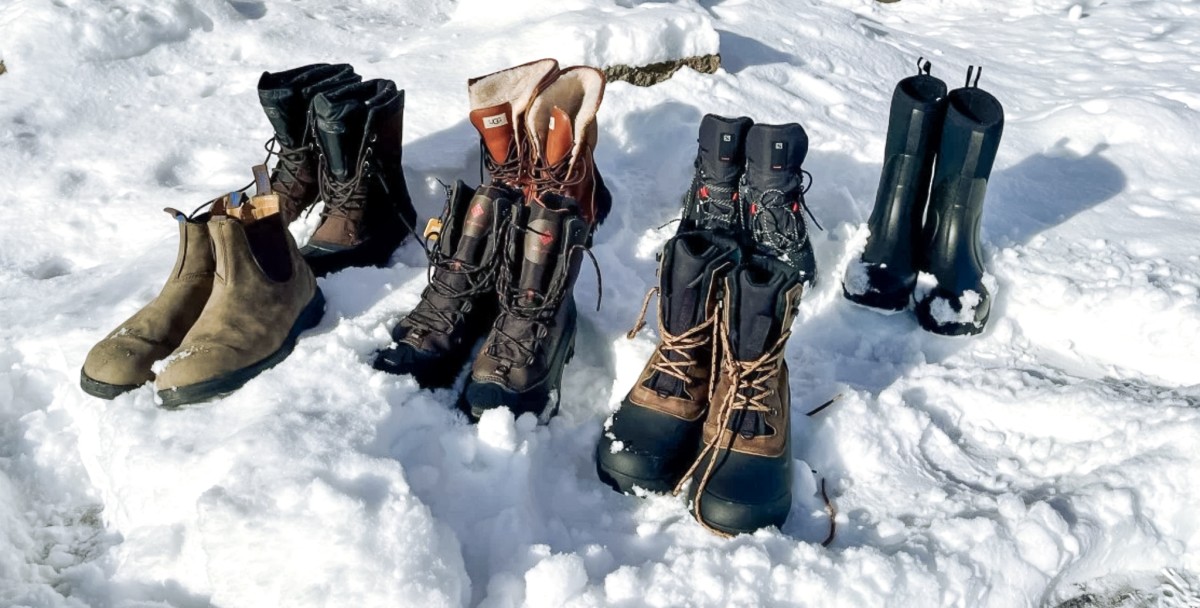Can Snow Boots Be Used for Hiking? Snow boots can sometimes be used for hiking in winter conditions. They provide warmth and waterproofing but may lack the support and tread of hiking boots.
Selecting the right footwear for outdoor activities is crucial for comfort and safety. Hiking trails demand sturdy, supportive boots designed for varied terrain, while snow boots are specialized for cold, snowy environments. Many enthusiasts debate whether snow boots can double as hiking footwear.
The primary considerations when venturing into nature are protecting your feet, maintaining traction, and ensuring adequate ankle support. While some crossover exists, snow and hiking boots are each tailored to their specific purposes. It’s worth understanding the differences to make an informed decision that will keep your adventures both safe and enjoyable. Remember, the right boot not only enhances performance but also minimizes the risk of injury.
Snow Boots Vs Hiking Boots
Explorers often question whether snow boots can serve as hiking boots. Understanding their differences is crucial for safety and comfort. Let’s dive into what sets these boots apart in various conditions.
Can Snow Boots Be Used for Hiking? Key Differences
Snow boots and hiking boots differ in build and functionality. The main distinctions lie in their design, insulation, and sole flexibility.
- Insulation: Snow boots have thick insulation to keep feet warm in cold temperatures.
- Sole Rigidity: Hiking boots feature stiffer soles for diverse terrains, unlike snow boots.
- Water Resistance: Both can resist water, but snow boots are designed to handle deep snow.
- Weight: Snow boots are generally heavier, potentially reducing hiking efficiency.
Design And Purpose
The design of each boot type caters to its specific purpose. Snow boots prioritize warmth and snow protection. Hiking boots focus on support and traction for varied landscapes.
| Feature | Snow Boots | Hiking Boots |
|---|---|---|
| Upper Material | Waterproof fabrics | Durable leathers or synthetics |
| Closure System | Laces or pull-on designs | Secure lacing systems |
| Midsole | Softer for comfort | Firmer for stability |
| Outsole Traction | Designed for snow grip | Optimized for various terrains |
In snowy trails, snow boots can be sufficient. Yet, for long hikes with varied conditions, opting for hiking boots is advisable.

Credit: www.outdoorgearlab.com
Why Consider Snow Boots For Hiking
Tackling frigid weather on the trail? Hikers might wonder if their snow boots can step up to the challenge. Built for the cold, these boots offer unique benefits for winter hikes. Let’s trek through the reasons why snow boots might just be the right fit for your next outdoor adventure.
Warmth And Insulation
Snow boots shine in frigid conditions. Unlike regular hiking boots, they come packed with insulation. This keeps toes cozy even when temperatures plummet. Check out the warmth perks:
- Thick, thermal linings lock in heat.
- Materials like thinsulate or wool create a warm barrier.
- High-cut designs help retain more body heat around the ankles.
Waterproof Qualities
Snow and slush demand boots that stay dry. Snow boots are up for the task. Their waterproof abilities are key for hikers. Here’s what makes them waterproof wonders:
- Sealed seams prevent water seepage.
- Water-resistant materials like rubber and Gore-Tex keep feet dry.
- Many models include gusseted tongues to block snow entry.
Limitations Of Snow Boots On Trails
Exploring snowy terrains often requires specialized footwear. Snow boots keep feet warm and dry. But using them for regular hiking has its drawbacks. It is vital to understand these limitations before hitting the trails.
Weight And Flexibility
Snow boots are heavier than hiking boots. This can slow you down on longer hikes. They lack the flexibility needed for varied terrains. Hikers often prefer lighter, more adaptable footwear for endurance and comfort. Multiple hours of walking with heavy boots can lead to fatigue. This is a critical consideration for distance treks.
- Heavier boots mean more energy exerted
- Less flexibility can hinder natural foot movement
- May cause discomfort or blisters over long distances
Traction And Stability
Traction is crucial on uneven trails. Snow boots are designed for icy surfaces. This means they may not offer the right grip on rocky or muddy paths. Stability is paramount when hiking. Snow boots may not provide this on non-snowy terrains.
| Feature | Snow Boots | Hiking Boots |
|---|---|---|
| Grip on Ice | Optimized | Varies |
| Grip on Rock/Mud | Not Ideal | Designed For It |
| Ankle Support | Good | Adaptable |
- Specific traction patterns may not suit all surface types
- Ankle support varies with the design of the boot
- Reduced stability can increase injury risk on challenging terrain
:max_bytes(150000):strip_icc()/tal-best-winter-hiking-boots-of-2023-tout-9a1b3a56eac6431fb3d39e09e0e4f18f.jpg)
Credit: www.travelandleisure.com
Trail-tested Tips For Hikers
Embarking on a winter hike? Snow boots may seem like a good fit. But, not all trails are suitable for your cozy winter footwear. Let’s explore how to make the best choice for a safe and pleasant hiking experience.
Choosing The Right Trail
It’s crucial to pick a path that matches your snow boots’ capabilities. Look for these features:
- Low Avalanche Risk: Safety comes first. Avoid trails with potential avalanche dangers.
- Stable Snow Conditions: Your boots do best on compact snow. Fresh, deep snow can be challenging.
- Flat to Moderate Inclines: Snow boots excel on gentle slopes. Steep terrains demand specialized gear.
- Short Distance: Favor shorter routes. Snow boots might not offer the best support for longer treks.
Adjusting Your Hiking Style
A change in footwear means adjusting how you hike. Here’s how:
- Slow Your Pace: Take your time. Quick steps can lead to slips or strains.
- Watch Your Step: Look out for ice. Snow boots may not grip like hiking boots.
- Take Breaks: Rest often. Snow boots are heavier, making your legs work harder.
Alternatives For Winter Hiking
When the winter chills set in, trails transform under the snowy blanket. Adventurers need the right gear to tackle these icy paths. While snow boots keep your feet warm, they might not offer the best support and traction for hiking. Let’s explore some viable alternatives that ensure safety, warmth, and comfort during your winter hikes.
Insulated Hiking Boots
Insulated hiking boots are designed for the cold terrain. These boots combine the warmth of snow boots with the support needed for hiking:
- Waterproof materials keep feet dry.
- Thick insulation ensures warmth.
- Grippy soles offer traction on ice and snow.
Select boots with adequate ankle support. This helps prevent injuries on uneven ground. Also, choose boots with a comfort rating below the lowest temperatures you expect.
Layering Techniques For Feet
Just like dressing in layers, your feet also need layers. Here are steps to keep your feet warm:
- Start with a pair of wicking socks to draw moisture away from the skin.
- Add a pair of wool or synthetic socks for insulation.
- Consider neoprene socks for an extra layer of warmth.
Don’t make your footwear too tight, as this can cut off circulation.
:max_bytes(150000):strip_icc()/Best-Mens-Snow-Boots-TL-tout-f7f19bbb01984e2f8dea0b6f677741dd.jpg)
Credit: www.travelandleisure.com
Frequently Asked Questions For Can Snow Boots Be Used For Hiking
Are Snow Boots Different From Hiking Boots?
Yes, snow boots and hiking boots are different. Snow boots have insulation for cold temperatures and often waterproof exteriors. Hiking boots focus on support and tread for varied terrain.
Can You Wear Snow Boots For Walking?
Yes, you can wear snow boots for walking. Choose lightweight, comfortable designs for longer walks.
Are Ski Boots Good For Hiking?
Ski boots are not ideal for hiking due to their rigid design and limited ankle mobility. They are specialized for skiing, not for the varied terrain encountered in hiking.
Can Snowshoes Be Used For Hiking?
Yes, snowshoes can be used for hiking in the snow. They provide stability and traction on snowy terrain, making winter treks easier.
Conclusion
Navigating snowy trails demands the right gear. While snow boots provide warmth, hikers may find their bulk limiting. For occasional treks, they can suffice, but dedicated hiking boots are best for frequent adventurers. Remember, the right footwear can make or break your outdoor experience.
Choose wisely, and happy hiking!

